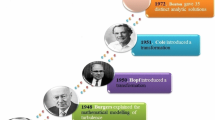Abstract
In higher-order closure models at least the pressure redistribution and the dissipation of the turbulent kinetic energy and the temperature variance have to be parameterized. Due to this, the introduction of proportionality coefficients — the so-called closure parameters — is forced, which have to be determined before the model is used. We compare a group of models which use the return-to-isotropy hypothesis (Rotta, 1951) to describe the pressure redistribution and assume local isotropy for the smallest eddies in order to parameterize the dissipation. Special concern is given to the method of Mellor and Yamada (1982). Some of the closure parameters are re-derived on the basis of sensitivity studies requiring that both shear production and buoyancy behave in a realistic way if pressure redistribution or dissipation is changed by varying the closure parameters. This set of parameters is compared with those obtained by fitting to experimental data, by use of the Monin-Obukhov similarity theory and by considering ratios of variances, covariances and mean flow gradients, respectively. It is shown that the various sets of closure parameters are at least of the same order. The differences give some insight into the advantages and disadvantages of the various determination procedures. However, the general accordance of the different parameter sets supports the assumption of universal constants.
Similar content being viewed by others
References
André, J. C., De Moor, G., Lacarrère, P., Therry, G., and du Vachat, R.: 1978, ‘Modeling the 24-Hour Evolution of the Mean and Turbulent Structures of the Planetary Boundary Layer’, J. Atmos. Sci. 35, 1861–1885.
André, J. C., De Moor, G., Lacarrère, P., Therry, G., and du Vachat, R.: 1979, ‘The Clipping Approximation and Inhomogeneous Turbulence Simulations’, in F. Durst, B. E. Launder, F. W. Schmidt, and J. H. Whitelaw (eds.), Turbulent Shear Flows I, Springer Verlag, Berlin.
Bremhorst, K. and Bullock, K. J.: 1973, ‘Spectral Measurements of Turbulent Heat and Momentum Transfer in Fully Developed Pipe Flow’, Int. J. Heat Mass Transfer 16, 2141–2154.
Champagne, T. H., Harris, K. G., and Corrsin, S.: 1970, ‘Experiments on Nearly Homogeneous Turbulent Shear Flow’, J. Fluid Mech. 41, 81–141.
Comte-Bellot, G.: 1965, ‘Ecoulement turbulent entre deux parois parallèles’, Publ. Sci. Tech. 419, Ministère de l'Air, Paris.
Deardorff, J. W.: 1973, ‘The Use of Subgrid Transport, Equations in a Three-Dimensional Model of Atmospheric Turbulence’, J. Fluid Eng. 95, 429–438.
Deardorff, J. W.: 1976, ‘Clear and Cloud Capped Mixed Layers: Their Numerical Simulation, Structure and Growth and Parameterization’, Seminars on the Treatment of the Boundary Layer in Numerical Weather Prediction, ECMWF, Reading, 327 pp.
Hanjalic, K., and Launder, B. E.: 1972, ‘Fully Developed Asymmetric Flow in a Plane Channel’, J. Fluid. Mech. 51/2, 301–335.
Kolmogorov, A. N.: 1942, ‘Equations of Turbulent Motion of an Incompressible Fluid’, Izv. Akad. Nauk. SSSR, Ser. Fiz. 6, 56–58.
Klebanoff, P. S.: 1955, Characteristics of Turbulence in a Boundary Layer with Zero Pressure Gradient, Rep. No. 1247, Natl. Adv. Comm. for Aeronaut., Washington, D.C.
Laufer, J.: 1950, Investigation of Turbulent Flow in a Two-Dimensional Channel, Tech. Note 2123, Natl. Adv. Comm. for Aeronaut., Washington, D.C.
Laufer, J.: 1954, The Structure of Turbulence in Fully Developed Pipe Flow, Rep. 1174, Natl. Adv. Comm. for Aeronaut., Washington, D.C.
Launder, B. E., Reece, G. J., and Rodi, W.: 1975, ‘Progress in the Development of a Reynolds-stress Turbulence Closure’, J. Fluid Mech. 68, 537–566.
Mellor, G. L. and Yamada, T.: 1982, ‘Development for a Turbulence Closure Model for Geophysical Fluid Problems’, Rev. Geoph. Space Phys. 20, 851–875.
Perry, A. E. and Abell, C. J.: 1975, ‘Scaling Laws for Pipe-Flow Turbulence’, J. Fluid Mech. 67, 257–271.
Reynolds, O.: 1893, ‘On the Dynamical Theory of Incompressible Fluids and the Determination of the Criterion’, Phil. Trans. Roy. Soc. A18b, 123–151.
Rose, W. G.: 1966, ‘Results of an Attempt to Generate a Homogeneous Turbulent Shear Flow’, J. Fluid Mech. 25, 97–120.
Rotta, J. C.: 1951, ‘Statistische Theorie nichthomogener Turbulenz’, Z. Phys. 129, 547–572.
So, R. M. C. and Mellor, G. L.: 1973, ‘Experiments in Convex Curvature Effects in Turbulent Boundary Layers’, J. Fluid Mech. 60, 43–63.
Webster, C. A. G.: 1964, ‘An Experimental Study of Turbulence in a Density-Stratified Shear Flow’, J. Fluid Mech. 19, 221–245.
Willis, G. E. and Deardorff, J. W.: 1974, ‘A Laboratory Model of the Unstable Planetary Boundary Layer’, J. Atmos. Sci. 31, 1297–1307.
Wyngaard, J. C. and Coté, O. R.: 1974, ‘The Evolution of a Convective Planetary Boundary Layer, A Higher-Order-Closure Model Study’, Boundary-Layer Meteorol. 7, 289–308.
Wyngaard, J. C., Coté, O. R., and Rao, K. S.: 1974, ‘Modeling the Atmospheric Boundary Layer’, Adv. Geophys. 18A, 193–212.
Yaglom, N.: 1977, ‘Comments on Wind and Temperature Flux-Profile Relationships’, Boundary-Layer Meteorol. 11, 89–102.
Yamada, N.: 1985, ‘Model for the Pressure Terms in the Equations for Second-Order Turbulence Moment, and its Application to the Atmospheric Surface Layer’, J. Met. Soc. Japan 63, 695–701.
Young, M. B. O., Hsu, E. Y., and Street, R. L.: 1973, ‘Air-Water Interaction: The Nature of Turbulent Heat, Mass, and Momentum Transfer Mechanism in the Air Boundary Layer’, Tech. Rep. No. 163, Dept. of Civ. Eng., Stanford Univ., California.
Zeman, O.: 1975, ‘The Dynamics of Entrainment in Planetary Boundary Layers: A Study in Turbulence Modeling and Parameterization’, Ph.D. Thesis, Pennsylvania State Univ., Pennsylvania.
Zeman, O. and Tennekes, H.: 1975, ‘A Self-Contained Model for the Pressure Terms in the Turbulent Stress Equation of a Neutral Atmospheric Boundary Layer’, J. Atmos. Sci. 32, 1808–1813.
Zeman, O., and Lumley, J. L.: 1976, ‘Modeling Buoyancy Driven Mixed Layers’, J. Atmos. Sci. 33, 1974–1988.
Author information
Authors and Affiliations
Rights and permissions
About this article
Cite this article
Wichmann, M., Schaller, E. On the determination of the closure parameters in higher-order closure models. Boundary-Layer Meteorol 37, 323–341 (1986). https://doi.org/10.1007/BF00117481
Received:
Issue Date:
DOI: https://doi.org/10.1007/BF00117481




